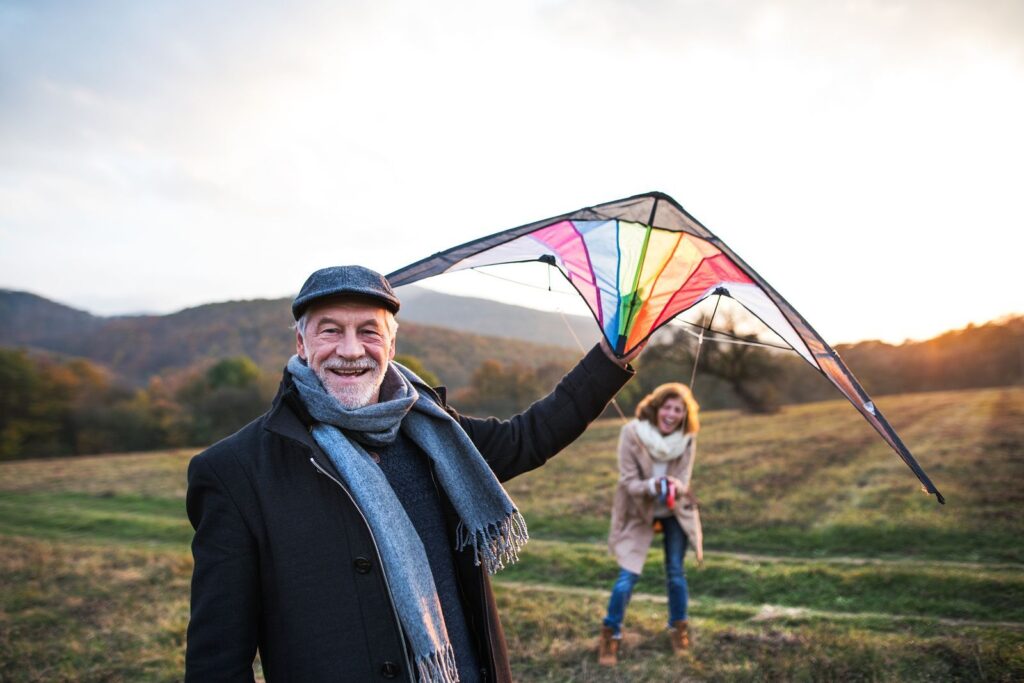
Go Fly a Kite!
A Fun Hobby for Anyone!
Flying a kite is fun for anyone at any age. It’s a perfect hobby for those of us in our seasoned years. Flying a kite is enjoyable, safe, and gets us outside for some fresh air and light exercise. And, once the kite is purchased, the rest of the kite flying adventure is free.
Flying a kite seems fairly straightforward, but it isn’t quite as simple as it seems. If you don’t know what you’re doing, you can end up with your kite tangled high up in a tree branch, broken to bits from an unexpected crash landing, or entwined with someone else’s kite. Of course, none of that can happen if you never your kite up into the air! And lift off can be more of a challenge than you might expect.
One of the most enticing things about kite flying is that it can be a solo or group activity. Launching a kite can be easier with a companion or two. Having a companion along also allows you to take a break and have someone else hold the kite’s line for a while, while is especially helpful if you tire easily or have physical limitations. Observing kites in flight can be entertaining no matter what your physical abilities or challenges may be.
Here’s some information that may help you get the hang of kite flying. Keep at it and pretty soon you will be out there enjoying yourself and making the art of flying a kite look easy to everyone else!
A few kite flying tips...
- Select the right kite for you. There are literally thousands of kites to choose from and each style flies differently. As a novice, you should pick a kite designed for beginners. It’s also a good idea to find a kite with bright colors you’ll be able to easily identify in the sky as well as on the ground if your kite lands or crashes unexpectedly.
- Find the right location. The best spots for kite flying are wide open areas with no obstacles. Grassy fields, public parks, and beaches are great. You should have plenty of clear space in front and behind you. Also make sure the area is clear of obstacles you could trip on as well as anything that might damage your kite.
- Fly in the right weather. Days with blue skies, sunshine, and a breeze are best for kite flying. If you can feel a breeze on your face and hear leaves rustling in the trees, there’s probably enough wind to fly a kite. Do not try flying your kite in heavy winds or under storm clouds. Obviously, lightening can be very dangerous for kite flyers. NEVER fly a kite during a thunder and lightning storm.
- Always stand on solid, dry ground. Avoid areas with loose gravel, dry sand, or wet grass, because they can cause you to slip and fall and lead to personal injury or a kite mishap. Also check the area for bumps or holes in the ground that could cause you to trip or fall.
- Do not run with your kite. You may think a running start is the best way to get your kite to rise into the sky or stay airborne, but it really isn’t. All you need is the right amount of wind and the air current will do all the work for you.
- Be aware of our surroundings. While kite flying, make sure you know what is going on around you at all times. Be aware of other kite enthusiasts as well as people and animals in the vicinity. Never fly your kite around small children or animals that might become frightened. Be especially careful not to spook horses with riders.
- Avoid obvious dangers. Never fly your kite around power lines or high rise buildings. Do not fly your kite near airports. Most airports in the United States prohibit kite flying within a specific area. Contact the local airport for restrictions. Keep your kite away from roads. If your kite were to come down on a roadway, it could cause a serious automobile accident.
- Seek professional guidance. Before taking your kite out for the first time, gather all the information you’ll need to be sure you know what you’re doing. Talk with someone at your local hobby or outdoor recreation store. Find out if there’s a kite flying club in your neighborhood. Read the directions that come with your kite. Look for reliable websites with tips about kite flying. Talk with your doctor to make sure your health status is appropriate for kite flying and whether you should follow any physical restrictions.
- Have fun and enjoy yourself. Savor each moment. Totally immerse yourself in the whole kite flying experience. Forget everything else for a while and just concentrate on keeping your kite in the air. Take pleasure in watching it soar against the blue sky. Take pride in your accomplishment.


Age Adds Flavor
We are not old, we are seasoned!
Don’t forget to visit us on FACEBOOK!
